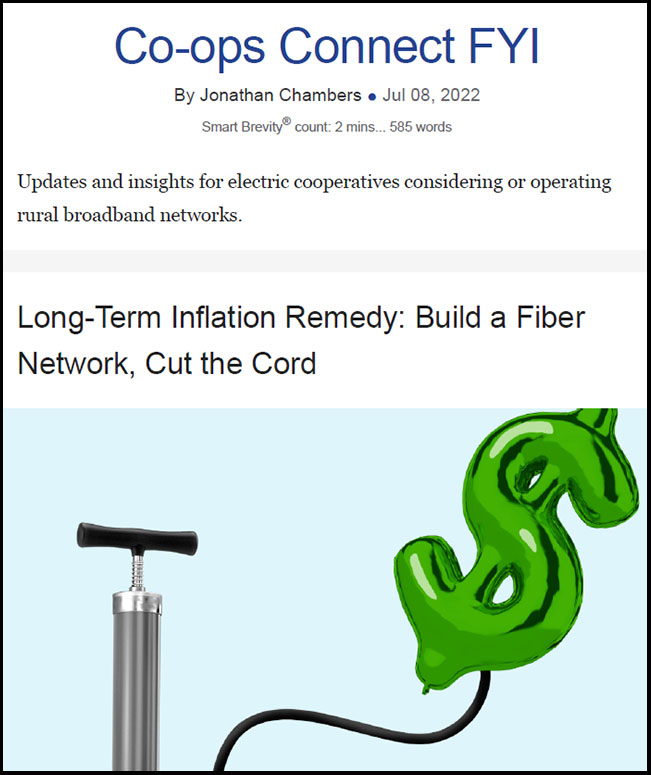Long-Term Inflation Remedy: Build a Fiber Network, Cut the Cord
July 8, 2022
Inflation can affect everything from gas prices to groceries, especially those goods and services for which there is no easy substitution. What does it mean for services like internet and TV?
According to the U.S. Bureau of Labor Statistics, prices for internet access services are 19.37 percent lower in 2022 than in 1997.
According to the U.S. Bureau of Labor Statistics, prices for cable and satellite television service are 135.24 percent higher in 2022 than in 1997.
Why it matters:
In rural areas, the population density generally doesn’t support the cable industry’s economics.
- While satellite services, such as Dish and DirecTV, ViaSat and HughesNet have offered television and internet access, without cable, rural Americans have paid more for less — fewer choices at higher prices.
- Where cable television and cable broadband are generally not available, inflation has been higher.
The Solution for Savings: Fiber Broadband and Video Streaming
Over the past five years, some of the nation’s largest companies have entered into the video streaming market to compete with cable.
- Google (YouTubeTV), Disney (HuluTV), and DirecTV Stream all offer packages of video programming that are comparable to traditional cable television packages.
- Apple, Amazon, Disney, and others also offer separate entertainment packages.
Since DSL does not support high-quality video streaming, the option of choosing competitive streaming video packages is not available for many rural households.
But:
Once fiber broadband service is available in a rural area, the choices and savings to rural residents become significant.
For example:
- Dish and DirecTV satellite services can cost $120-140 a month.
- 100 Mbps service from Starlink costs $500 for installation and then $100 per month.
The difference:
A 100 Mbps fiber service allows consumers to stream any number of television packages. All mimic traditional cable systems for less money.
- DirecTV Stream combined with 100 Mbps fiber service costs less than satellite television alone.
- The combination will save an average household $50-100 per month.
The bottom line:
For a co-op, investing in a fiber network will save members over $1,000 annually in internet and television services. Those savings will continue for decades.
The Big Picture
This is why it is so important to eliminate inflationary provisions of NTIA’s BEAD program.
- Additional costs imposed on rural networks will be passed on to rural households in the form of higher prices.
- The Biden Administration is keen on eliminating inflation.
- Yet: NTIA seems to have a tenuous understanding of the impact on their policies and the additional long-term costs on living in rural America.
As previously described (see May 20 edition), NTIA’s requirements will add 25-50 percent to the cost of building a broadband network. These extraneous requirements include:
1. A cybersecurity plan
2. A climate resiliency plan
3. A supply chain risk management plan4. A middle-class affordability plan
5. A project workforce continuity plan for those not using union labor
6. Environmental and historical preservation surveys
7. Prevailing wage requirements
8. Bank letters of credit
9. Participation in workforce training and apprenticeship programs
10. New and more restrictive Buy America requirements
The bottom line:
Who will pay for NTIA’s social engineering? Rural America in the form of higher prices for broadband.
My recommendation:
State governors should ensure their applications for broadband funding include a waiver request of federal policies that impose cost on building broadband networks.
If NTIA chooses not to grant such waivers, the next Congress should direct NTIA to accept state waiver requests.
